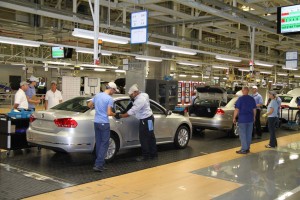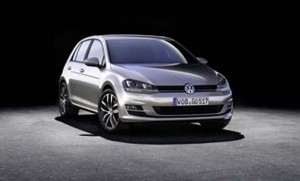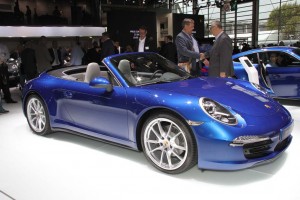Every so often, a product comes along that transforms the auto industry. Henry Ford’s Model T was one example. So was the original Volkswagen Beetle.
Despite the usual marketing hype, the third-generation Beetle that VW launched last year is far from a revolutionary breakthrough – or so it might seem at first glance. From a designer’s view, it is a morph somewhere between the original “people’s car” and the so-called “New Beetle” of a decade back.
Yet, a closer inspection suggests that the latest iteration of the iconic coupe is far more revolutionary than might initially meet the eye. That’s because the real breakthrough comes in the way the newest Beetle – and virtually everything else that will now be developed by the German automotive giant – is being designed and manufactured.

Going forward, any model using the new MQB platform -- from the little Polo to the big Passat, shown here -- could roll down the same VWAG assembly line.
If the project proves “stable,” in the words of VW’s technology czar, it could yield a 30% reduction in the cost of building the typical vehicle – while allowing the maker to add new models for surprisingly little investment – and in a fraction of the time it normally takes to bring a vehicle to market.
Once upon a time, automakers developed specific platforms – sometimes called a chassis, sometimes an architecture – for each individual vehicle. In recent decades, makers have gotten smarter and more efficient, finding ways to share platforms among multiple products. Ford Motor Co., for example, plans to offer as many as 10 different models based on the underpinnings used for its compact Focus model, including the new 2013 C-Max “people-mover.”
Even the most flexible of these platforms usually have narrow limits as to how much flexibility they permit a maker in terms of length or width or height – or whether a vehicle can have its engine up front or in the back, or drive the front, rear or all four wheels. If Volkswagen achieves what it set out to do with a far more ambitious approach to platform development, however, many of these limits will vanish.
The maker currently offers 245 different models shared among its dozen brands and the vast majority, going forward, will share the same underpinnings found in the latest Beetle and the even newer remake of the Golf. Codenamed MQB, this platform will act as the foundation, in fact, for a dizzying array of seemingly unrelated models – everything from the subcompact Volkswagen Polo to the midsize Passat sedan as well as the VW Tiguan and Audi Q3 crossovers.
A second platform, dubbed MLB, will serve products as diverse as the Audi A4, A6 and A8 sedans, the new Porsche Macan sport-crossover and possibly even a future Bentley, hints Dr. Ulrich Hackenberg, Volkswagen’s Board Member in Charge of Technology. Audi, he notes, is overseeing the development of this platform which can mount its engine in either the front of the vehicle or the rear.
A third platform, codenamed MSB, will handle performance machines and bigger vehicles, especially those using front engines and rear or all-wheel-drive. No surprise, this package is the responsibility of the newest member of the 12-brand VW family, Porsche.
A final platform — known as NSF, for New Small Family — was a late addition and will focus on a new generation of microcars, such as the Volkswagen Up and perhaps even the tiny, low-cost offerings that the German maker is considering for an all-new brand specifically targeting emerging markets such as Indonesia or India.
Each platform has wide flexibility in terms of the basic size of the vehicle and the sort of powertrain technology that can be used, according to Hackenberg. Notably, one of the goals is to essentially create a computer-like plug-and-play toolkit of different powertrains so any individual VW product will be able to use an assortment of gas and diesel engines, hybrids, plug-ins, pure battery-electric drive and other technologies under development – such as a hydrogen fuel cell drive.
“The MQB platform, (for one), will allow us to potential bring any powertrain into the car,” Hackenberg explains. “It will just depend on the market” requirements.
But the biggest benefit will come from driving down product development and production costs. On the manufacturing side, he says, “We expect, if the process is stable, to save 30% on total assembly costs,” once the new platform strategy is fully implemented.
Perhaps equally important, the engineering chief quickly adds, it that, “this is a key enabler” to produce even more niche and specialty vehicles. That’s particularly critical in the modern automotive market where customers won’t settle for me-too products but want vehicles that meet their precise needs and desires.
Another advantage, VW believes, is that by “communizing” key elements of vehicle design that matter little to consumers it will be easier to share innovations and features – such as radar-guided Active Cruise Control, backup cameras or infotainment systems – that might otherwise be restricted to more expensive models, according to VW officials, who have dubbed the strategy “democratizing innovation.”
The new platform strategy is being paired with other engineering and manufacturing breakthroughs – such as the hot-formed steel stamping process introduced on the all-new, 2013 VW Golf. That technology helped shave significant weight off the new model while also increasing its strength and crashworthiness, Hackenberg claims.
“This is something we’re very aware of – and very concerned about,” acknowledges a senior executive involved in advanced product development at General Motors which sees Volkswagen as one of its key global competitors. “By the time we figure it out they may have a several-year lead on us,” he confided to TheDetroitBureau.com.
“I have no doubt this is an incredibly flexible (approach) and that they’re saving lots of money,” adds Jim Hall, head of Detroit-based automotive consulting firm 2953 Analytics. And it will give the maker the flexibility to hold down product costs – if competition demands – or pass the savings onto shareholders, suggests Hall.
He cautions that VW isn’t the only global maker working to reduce development and production costs even while making its platforms more flexible. Toyota has similar goals, for one. But he says it puts VW “in the hunt” as it sets out an ambitious goal to become one of, if not the, best-selling and most profitable automaker worldwide by the end of the decade.


